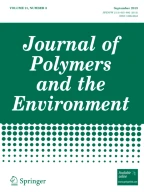Abstract
This paper presents a life cycle assessment (LCA) comparing three forms of poly(lactic acid) (PLA) disposal: mechanical recycling, chemical recycling and composting. The LCA data was taken from lab scale experiments for composting and hydrolysis steps. Polymerization data in chemical recycling was obtained from computer simulation. Mechanical recycling data from lab scale were combined with the data from a plastics commercial mechanical recycling plant. The analysis considered two different product systems based on the input of the recycled PLA in the product system. Considering the categories: climate change, human toxicity and fossil depletion, the LCA showed that mechanical recycling presented the lowest environmental impact, followed by chemical recycling and composting. Among the forms of recycling, the most important input was the electricity consumption.
Similar content being viewed by others
Explore related subjects
Discover the latest articles, news and stories from top researchers in related subjects.References
Auras R, Lim LT, Selke SEM, Tsuji H (2010) Poly(lactic acid)—synthesis, structures, properties, processing, and applications. Wiley, New Jersey
Vink ETH, Rábago KR, Glassner DA, Springs B, O’Connor RP, Kolstad J, Gruber PR (2004) Macromol Biosci 4:551
Vink ETH, Glassner DA, Kolstad JJ, Wooley RJ, O’Connor RP (2007) Ind Biotechnol 3:58
Vink ETH, Davies S, Kolstad JJ (2010) Ind Biotechnol 6:212
Vink ETH, Davies S (2015) Ind Biotechnol 11:167
Groot WJ, Borén T (2010) Int J Life Cycle Assess 15:970
Álvarez-Chávez CR, Edwards S, Moure-Eraso R, Geiser K (2012) J Clean Prod 23:47
Souza PMS, Corroque NA, Morales AR, Marin-Morales MA, Mei LHI (2013) J Polym Environ 21:1052
Hermann BG, Debeer L, De Wilde B, Blok K, Patel MK (2011) Polym Degrad Stabil 96:1159
Detzel A, Krüger M (2006) Life cycle assessment of PLA: a comparison of food packaging made from NatureWorks® PLA and alternative materials. IFEU Heidelberg, Heidelberg
Papong S, Malakul P, Trungkavashirakun R, Wenunun P, Chom-in T, Nithitanakul M, Sarobol E (2014) J Clean Prod 65:539
Rossi V, Cleeve-Edwards N, Lundquist L, Schenker U, Dubois C, Humbert S, Jolliet O (2015) J Clean Prod 86:132
Piemonte V, Sabatini S, Gironi F (2013) J Polym Environ 21:640
Zenkiewicz M, Richert J, Rytlewski P, Moraczewski K, Stepczy’nska M, Karasiewicz T (2009) Polym Test 28:412
Pillin I, Montrelay N, Bourmaud A, Grohens Y (2008) Polym Degrad Stabil 93:321
Carrasco F, Pagès P, Gámez-Pérez J, Santana OO, Maspoch ML (2010) Polym Degrad Stabil 95:116
Cosate de Andrade MF (2015) Estudo da avaliação de ciclo de vida do PLA: comparação entre a reciclagem química, mecânica e compostagem. Masters dissertation. UNICAMP, Campinas
International Organization for Standardization (2006) ISO 14040. Environmental management. Life cycle assessment. Principles and framework
International Organization for Standardization (2006) ISO 14044. Environmental management. Life cycle assessment. Requirements and guidelines
Mallet B, Lamnawar K, Maazouz A (2014) Polym Eng Sci 54:840
Jaszkiewicz A, Bledzki AK, van der Meer R, Franciszczak P, Meljon A (2014) Polym Bull 71:1675
Meng Q-K, Heuzey M-C, Carreau PJ (2012) Int Polym Proc 27:505
Garraín D, Vidal R, Franco V, Martínez P (2008) Residuos 104:58
Perugini F, Mastellone ML, Arena U (2005) Environ Prog 24:137
Martínez GAR (2011) Modelagem e simulação do processo de produção de PLA (poli-ácido láctico) obtido a partir de fontes renováveis para uso biomédico. Masters dissertation. UNICAMP, Campinas
Piemonte V, Gironi F (2013) J Polym Environ 21:313
Kumar Suri A, Banerjee S (2006) Tin Mater Sci Technol. doi:10.1002/9783527603978.mst0079
Asthana N, Kolah A, Vu DT, Lira CT, Miller DJA (2005) Org Process Res Dev 9:599
Vu DT, Kolah AK, Asthana NS, Peereboom L, Lira CT, Miller DJ (2005) Fluid Phase Equilib 236:125
Krause MJ, Townsend TG (2016) Environ Sci Technol Lett 3:166
Gentil E, Christensen TH, Aoustin E (2009) Waste Manag Res 27:696
International Organization for Standardization (2007) ISO 14855-2. Determination of the ultimate aerobic biodegradability of plastic materials under controlled composting conditions—method by analysis of evolved carbon dioxide-Part 2: gravimetric measurement of carbon dioxide evolved in a laboratory-scale test
Souza PMS, Morales AR, Mei LHI (2014) Polímeros 24:110
Ministério do Meio Ambiente (2010) Manual para implantação de compostagem e de coleta seletiva no âmbito de consórcios públicos
Razza F, Innocenti FD (2012) Asia-Pac J Chem Eng 7:S301
Goedkoop MJ, Heijungs R, Huijbregts M, De Schryver A, Struijs J, Van Zelm R (2008) A life cycle impact assessment method which comprises harmonised category indicator at the midpoint and the endpoint level. First edition report 1: characterisation
Frischknecht R, Jungbluth N et al (2003) Implementation of life cycle impact assessment methods: final Report Ecoinvent 2000. Swiss Centre for LCI, Duebendorf
Ministério de Minas e Energia (MME) (2015) Resenha Energética Brasileira. Ministério de Minas e Energia
Siqueira JE, Henkes JA (2014) R Gest Sust Ambient 3:359
Acknowledgments
The authors are grateful to FAPESP (Process Number 2014/09883-5) and CAPES by the financial support and to the company Wisewood Soluções Ecológicas S.A. (Brazil) for the recycling process data.
Author information
Authors and Affiliations
Corresponding author
Rights and permissions
About this article
Cite this article
Cosate de Andrade, M.F., Souza, P.M.S., Cavalett, O. et al. Life Cycle Assessment of Poly(Lactic Acid) (PLA): Comparison Between Chemical Recycling, Mechanical Recycling and Composting. J Polym Environ 24, 372–384 (2016). https://doi.org/10.1007/s10924-016-0787-2
Published:
Issue Date:
DOI: https://doi.org/10.1007/s10924-016-0787-2
